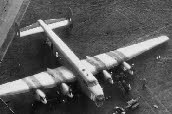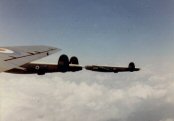The Shackleton Story by Bill Billings
(photos by Bill too!)
Part One
A V Roe, known from aviation time immemorial as AVRO, at the cessation of hostilities in 1945, had some experience of Maritime Reconnaissance aircraft design and production; these ranged from the Anson to converted Lancaster ASR Mk 3s,. which could – and did – carry an Airborne Lifeboat. This was promising, and ever like most things promising for Coastal Command, was severely compromised when many were converted back to General Reconnaissance variants, in order to make up a shortfall in that field. Meanwhile, while our cousins in Bomber Command were re-equipped with four-engined heavies, we in Coastal got their cast-off Whitleys and Wellingtons and a smaller number of Liberators. The latter having four engines, were fairly soon claimed by Bomber Command.
With early marks of ASV coming into service, the construction of the Wellington meant that the nose-mounted radar could only operate over a 60 degree arc ahead of the aircraft. Being Coastal, 60 degrees was better than nil degrees, and that rather unsatisfactory compromise was what we got, together with the Leigh Light wing mounted searchlight to illuminate the target ( while providing an aiming point of the aircraft for surface weapons). Improved marks of ASV were appearing, but Bomber snaffled the latest ones, as H2S, again at the expense of Coastal. However, with U-boat kills and denial of the surface by aircraft increasing, a new Air Staff Requirement was issued, too late for WW2 of course, for a new land-based Maritime Reconnaissance aircraft. This culminated in Specification R5/46, which became the Shackleton GR Mk 1, Type 696.

Originally to be known as the Lincoln Mk 3, due to its main Spar and wing ancestry, but ’fatter‘ shorter and much more powerful, it was named the Shackleton by Roy Chadwick, who had joined the infant A V Roe as a draughtsman in 1911 aged 18, and rose to become Chief Designer, collecting the CBE, and qualifying as an MSC, ERSA, FRAeS and AMCT over the years. The first prototype VW126 made its first flight on 28 March 1950, with Jimmy Orrel (an ex Halton ‘brat’) at the controls . Sadly, Chadwick did not live to see that first flight of the Shackleton; he was killed aged 54 in 1947 in the prototype Tudor Mk 11 in the first accident identified clearly caused by Murphy‘s Law. The aileron controls had been reversed after the aircraft was serviced.
Did their Airships know what they were starting? Not all the stuff about airframe numbers and issues, but the people. Coastal Command had been long in existence. Now a new breed of aircrew was in the making; the Shackforce. Although as squadrons re-equipped with Shackletons, progressing from Mk 1 and Mk 1As to Mk 2, ( and then back again as did 204 in 1959), and then, to some, Mk 3s of various phases, an ever increasing number became Shackleton men – and very many of them forever. How about us, and some of the little known facts and fallacies about the Shackleton and its interface with those who flew it – and who strangely enough look back to those times with fond nostalgia, some wryness and, possibly, a great feeling of relief for some when it was all over? I write these words of what may be long known to many, but may perhaps be illuminating to the other members of our Association. There is more to tell than semi line-shoots overheard in certain bars after a drink or six.
Of course, we all know the difference between Mks 1, 2 and 3, and even some of the various phrases, don’t we? However, I am asked, what was the difference between Mk 1 and Mk1A? We didn’t have all that Phase stuff then. Well, typically of the marque (I know, I know) the Mk 1 had DIFFERENT ENGINES in the inboard and outboard nacelles! AND, they were not interchangeable. Honestly! Our older, trusted engine men may remember the Griffon 57 and the 57A. Anyway, after modification to production line Marks, and retrofit modification to the engine nacelles of the Mk 1s already in service, we had as close to a standardisation principal as was probably ever experienced by the Shackforce, with several squadrons!
Specification 42/46, issued to cover production aircraft, actually officially changed the designation to Maritime Reconnaissance (Maritime recce for the benefit of those without spellcheckers) and the aircraft hence forward became MR1’s, MR1As and so on, possibly making it slightly less likely that they would be snaffled by Bomber Command for tasks such as Colonial Policing (Kenya, not Arabian Gulf, as by the time of the Radfan rebels problem, colonial policing had been assigned to Coastal). Naturally, these changes quickly brought about the development of the more robust Griffon 58, which powered the Mark 2 aircraft, which had 20mm cannon in a fixed nose turret, replacing the originally planned fixed cannon housed in ‘cheek’ barbettes each side of the nose, a tail rear observation (and quiet kipping position), retractable twin tailwheels and other less significant changes.

If really interested in exactly who got what, when and why, refer to Aircraft Profile No 243, by Peter Howard, published by Profile Publications. Also the excellent ‘Avro Shackleton’ by Barry Jones, an expensive tome from the Crowood Aviation Series, albeit with a few incorrect statements, (you must ask, and I will tell) and ‘Shackleton at War and Peace, by John Chartres, published by Ian Allan Ltd. These volumes give all the facts, figures and dates, with not a few pictures. However, for instant reference and to settle a few differences of opinion, the first squadron to get the Shack was....no, NOT you lot with a short(ish) squadron number (we all know who you are, rhymes with ‘who?)) but 120! On 3rd April 1951 VP 258 was delivered to 120Sqn at Kinloss. As a suitable reward, the squadron was moved to Aldergrove leaving a nucleus which became 240Sqn in 1952 and receiving VP255. 269Sqn then at Gibraltar received VP256 in February 1952, and as a punishment, the whole squadron was moved to the cooler climes of Ballykelly, (where it remained until renumbering as 203 some years later with Mk 3s.)
